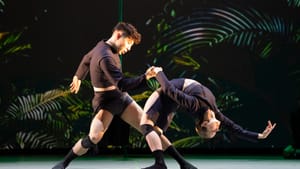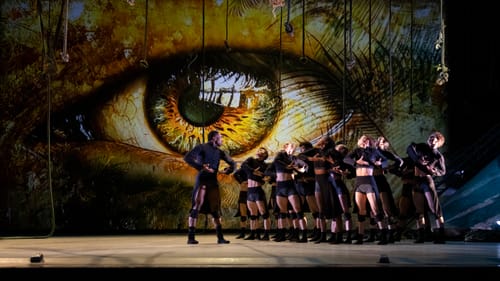Stay in the Loop
BSR publishes on a weekly schedule, with an email newsletter every Wednesday and Thursday morning. There’s no paywall, and subscribing is always free.
Lord of the Flies becomes a full-length ballet
BalletX’s Festival at the Mann presents Maslow’s Peak by Jennifer Archibald

In 2024, BalletX gave us a preview of Jennifer Archibald’s Maslow’s Peak, inspired by William Golding’s Lord of the Flies. It was breathtaking, and I couldn’t wait to see the finished piece, which debuted May 2-3, 2025, at the Mann Center for the Performing Arts.
Archibald wanted to do a new kind of story ballet, not a Russian-style fairy tale but something that spoke to our times. Happily, I can say that the full-length work succeeded beyond my imagination. The huge production swallowed up the TD Pavilion stage and dropped us into designer Guy De Lancey’s eerie tableau of dangling rope vines and projections of lush foliage. Birds sang and monkeys screeched in Archibald’s soundscape, giving way to vocals just on the edge of words. From time to time, an enigmatic eye cast its amber glow over the stage.
To one side, we saw the broken wing of a downed aircraft, and to the other, a strut, like a ladder, leaned precariously at the stage wing. A cliff of sorts, low enough for the dancers to climb on, but still with its sense of danger, loomed beside the strut, and a set of airplane seats occupied the center, dividing the space into three sections.
Overhead, Itzkan Barbosa, Lanie Jackson, and Ben Schwarz hung from the vines as if unconscious, then slithered or spun to the stage as a knot of dancers untangled themselves from the seats (that were quickly whisked away behind them). The plane crash left the story’s school-age survivors to fend for themselves. In designer Emily Morgan’s torn school uniforms, they faced us in a line, their arms bent forward as if fighting their way through the jungle.
Golding meets Maslow
The ballet takes its title from yet another inspiration, Abraham Maslow’s hierarchy of needs, which says that the peak, self-fulfillment, requires the satisfaction of more basic needs, like food and shelter. Archibald used Golding’s novel to explore the conflicts of our own time when even the most basic needs become a struggle.
Jerard Palazo danced the protagonist (Ralph in the book). His uniform, with a longer, nipped-in coat, added to his stately posture as he drew the group together at his feet. His duet with Francesca Forcella was lovely, with long lines and a playful connection as she booped him gently in the chest with her head. The soundscape took an ominous turn when Jared Kelly (Jack in the book), in a similarly commanding coat, rose up to oppose him, drawing away his own proponents. The conflict between the two leaders played out in a break-dancing battle at center stage, surrounded by their followers.

The dancing was angular and fast, with the energy rising from centers of gravity low over bent knees. The dance gave us more classical forms in the skyward stretch of the corps when a plane flew by in the distance, or when a cabriolet suddenly burst out of a scatter of dancers leaping in a style more inflected with street dance. The company was precise in the ensemble pieces and athletic in ways we do not usually see in the ballet: dancers clambered over the cliff and raced up the wing of the plane to slide down again, while Skyler Lubin climbed nearly to the rafters on that strut from the plane, watching over the action. Act one ended with Kelly’s followers, the force for savagery. As the lights dimmed, we saw that he wore a large mask of a beast that faded into the darkness until nothing remained but its glowing orange eyes.
Time had passed in Act 2; the costumes were more tattered, and the projection showed a parched landscape. All of Kelly’s followers now wore masks and actively pursued the other side. In the lifts, dancers were carried upside down, or spun on the shoulders of their partners, or kicked out as if trying to escape. The company fought with twirling spears until it seemed that all but the protagonist had changed sides, and in a shocking scene, the dancers crowd around as forces of savagery beat him and dragged him away. Maslow’s Peak ended on a hopeful note, however. The castaways faced their guilt and renounced their savagery to come together at last.
Will we ever see it again?
Before the curtain opened, artistic and executive director Christine Cox said that the piece was the biggest production BalletX had ever done. It was, indeed, a spectacular production using all the dynamic possibilities of the Mann’s huge stage. That is both a blessing—it was fabulous—and a curse. As the performance came to a close, I wondered when we would ever see it again. It can, of course, be modified to fit a smaller theater, but much of its impact comes from the scale and the way the story’s setting became a part of the natural landscape of the TD Pavilion.
What, When, Where
Maslow’s Peak. Choreography by Jennifer Archibald. $25. BalletX, presented by Festival at the Mann. May 2-3, 2025, at the Mann Center for the Performing Arts, 5201 Parkside Avenue, Philadelphia. (215) 225-5389 or balletx.org.
Accessibility
The Mann Center is an ADA-compliant venue.
Sign up for our newsletter
All of the week's new articles, all in one place. Sign up for the free weekly BSR newsletters, and don't miss a conversation.

 Camille Bacon-Smith
Camille Bacon-Smith